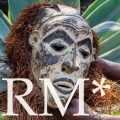Jos van Beurden writes:
Ideally, I would have written an entire book about the colonial collections of art dealers, auction houses and private collectors. In my book The Empty Showcase Syndrome, more comprehensive knowledge about this private sector is called one of the three toughest issues in the restitution discourse.
The research for the chapter Come Out, Private Collector and Art Dealer gave insufficient grasp of the subject. It deserves more study.
For many, the restitution debate has further thickened this wall. At the same time, the few holes in it that can be discovered offer enough evidence that this sector is full of surprises worth studying.
‘No one talks to you’
It was in the spring of 2024 that I raised the topic of colonial collections in the art trade at Maastricht University, and an art dealer present among the audience thought I was talking too negatively about the trade. Furiously he snapped at me: ‘No art dealer talks to you! Everyone in the trade does pay attention to the provenance of pieces these days’.
Since I had just spoken to some larger art dealers and had long understood that restitution issues are also being considered in that sector, the man had a point.
Auction houses
In recent years, the easiest place to discover surprises has been at auction houses. There one can see ancestral remains, weapons, religious objects, ancient manuscripts, and other treasures, which private collectors and art dealers from all walks of life that come under the hammer there. Among them:
- Ancient Fang mask from Gabon in West-Africa, taken by a French colonial administrator around 1920 (Hôtel des Ventes, Montpellier, France)
- Ancient bronze Buddha head from Ayutthaya, World Heritage site in Thailand (De Zwaan, Amsterdam, the Netherlands)
- Ancient Fon skull (De Zwaan, Amsterdam, the Netherlands)
- Ancient weapons, manuscripts, and utensils taken during a British raid in Abyssinia/Ethiopia in 1868 (Auction House, Bidford, UK; Venue Huis, The Hague, the Netherlands; Anderson and Garland, Newcastle, UK)
- Golden medal of an Ethiopian army commander also son-in-law of Emperor Haile Selassie, seized by an Italian soldier in 1937 (Galerie Numismatique, Lausanne, Switzerland)
- Skulls of rebels in colonial Congo, taken by an army doctor (Vanderkindere, Ukkel, Belgium)
- Skulls from Dayak and Asmat people in Indonesian Papua and Papua New Guinea (Marktplaats, the Netherlands)
- Shrunken heads from Nagaland, India (Swan, Tetsworth, Oxfordshire, UK).
Sometimes, the auctioning of these objects and especially of human remains evokes public outrage and in some instances, this led to their withdrawal from the auction. The auctioneer had to return them to the owner who had offered them. Rarely is known what happens to them further, and they may be sold privately.
These finds of objects and ancestral remains from colonial regions suggest that there must be many more. In this sense, they are comparable with items popping up in the on-going illicit trade in art and antiquities, which I studied in the 1990s and 2000s. The finds at that time also were just the tip of the iceberg.
Two temple guards
Art dealers occasionally offer a surprise openly at exhibitions, art fairs, through catalogues and their websites. At ‘The Great Indonesia Exhibition’ in De Nieuwe Kerk in Amsterdam (21.10.2023 – 01.04.2024), two Javanese temple guards were prominently displayed. The caption said they came from a private owner and earlier had been exhibited and described.
An official of the ‘Tim Repatriasi’, Indonesia’s restitution committee, with whom I visited the exposition, expressed his surprise at the presence of this type of objects in the Netherlands. ‘We know nothing about this. Should we not claim them?’
Then something extraordinary happened. A few weeks before the exhibition closed, the two guards were removed and few days later, during a visit to the 2024 TEFAF art fair in the Dutch city of Maastricht (11-19 March), I discovered by chance the two guards in the stand of ‘Polak Works of Art’, a Dutch gallery. The caption mentioned that the statues had been at the prominent exhibition. This elevated their status.
Not a book, but blogs
Finds of colonial collections in the private sector, whether dubiously acquired or not, are accidental. Diaspora organisations, countries of origin and committed people in the global north play a crucial role in it.
Most collections are accompanied by much less background information than collections in the museum sector.
Moreover, apart from the wall around the private sector bulwark, the quantity of items and owners is so large, that it is very hard to get useful insights on all objects being traded. That would require many more years of research and many more researchers. Therefore, it is too early to write a comprehensive book on it.


